We examine the question of whether extending the duration of mortgage makes financial sense (and for who?).

Digital Finance Analytics (DFA) Blog
"Intelligent Insight"
We examine the question of whether extending the duration of mortgage makes financial sense (and for who?).

We examine the question of whether extending the duration of mortgage makes financial sense (and for who?).
A mortgage brokerage has welcomed and affirmed the sentiment yesterday expressed by Treasurer Josh Frydenberg that “hard-working families” are being negatively impacted by stricter responsible lending rules, via Australian Broker.
Aussie Home Loans CEO James Symond said, “We are concerned about customers being knocked back on home loan applications due to stringent interpretations of rules by APRA and ASIC.”
According to Symond, there is cause for concern over the low property listings and the downturn in construction activity, despite historically low interest rates, the likelihood they will continue to fall and auction clearance rates picking up.
Speaking at The Australian Financial Review’s Property Summit in Sydney yesterday, Frydenberg welcomed the increase in housing prices and linked the stabilisation in the housing sector to the easing of lending regulations — measures, he emphasised, that “at the time achieved their desired objectives” through mitigating risks associated with investor loans, interest-only lending and serviceability.
Speaking of responsible lending, Frydenberg said, “While these obligations were first legislated back in 2009, the shadow of the Royal Commission and recent litigation has given rise to uncertainty as to how they ought to be implemented in practice.”
“Common sense dictates that a sensible balance needs to be struck because an unduly restrictive application of these obligations can do as much harm as an overly lax one.
“Should responsible lending laws be applied too stringently, they will also negatively impact consumer behaviour with consumers more likely to remain with their current provider than go through the red tape burden associated with looking for alternatives.
“It is in everyone’s interest that the aspirations of hard working families are not collateral damage in this regulatory process.”
A recent study commissioned by Aussie revealed an overwhelming lack of consumer confidence both in the housing market and in their prospects of securing a home loan.
Just one-third of Australians are more confident about buying a home than they were five years ago, despite record low interest rates and lower property prices.
The study also found 70% described the home loan process negatively, calling it ‘stressful’, ‘a waiting game,’ ‘overwhelming,’ ‘confusing,’ ‘difficult,’ ‘painstaking’ and ‘rigid.’
Further, about 29% of Australians are waiting to buy property despite promising market conditions as the home loan process has been described as hard to navigate and riddled with red tape.
“This is why it is so important for the regulators to act to restore Australians’ confidence in the housing market and their ability to buy property,” said Symond.
So, just worth remembering the high levels of mortgage stress in the system currently – at ultra low rates, based on our analysis to end August 2019.
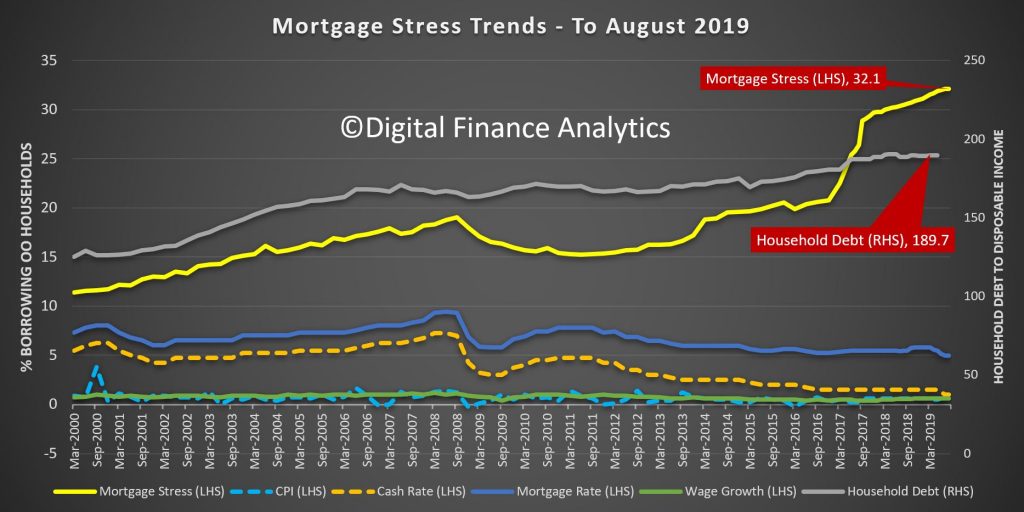
As we discussed yesterday, there is only one game in town, more mortgage growth, but that game is deeply flawed….
The recent RBA Bulletin included an article “Bank Balance Sheet Constraints and Money Market Divergence“, which in summary shows that money market trades have generally not been profitable for the four major banks since the financial crisis.
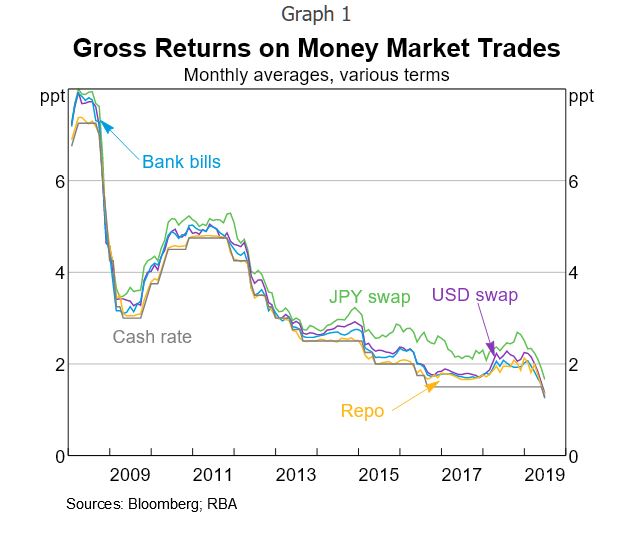
This is partly because debt funding costs have fallen by less than money market returns. In addition, equity funding, which is more expensive than debt, has increased. Consequently, the incentive for banks to arbitrage between money market interest rates has fallen.
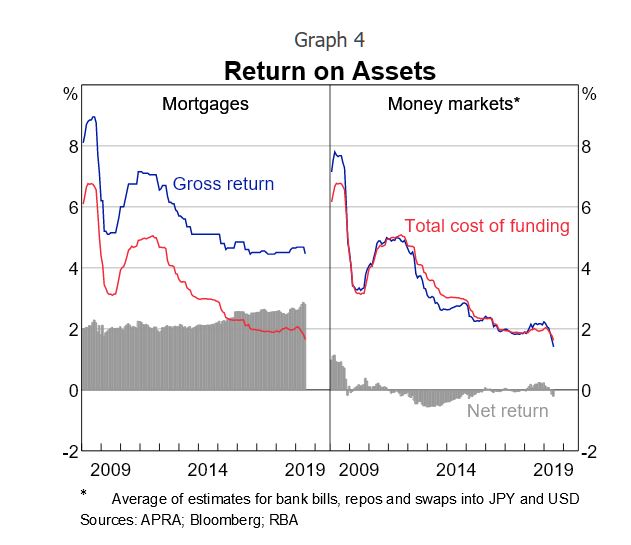
They show that residential mortgages are always significantly more profitable than money market trades over the sample period (Graph 4). This suggests that there has been a substantial opportunity cost associated with diverting equity funding away from mortgages and towards lower-margin activities such as money market trading. This is consistent with the balance sheets of the major banks being weighted towards mortgages and away from trading investments.
According to the latest property exposure statistics from the Australian Prudential Regulation Authority (APRA), the ADI’s sector exposure to residential mortgages increased by 3.6 per cent when comparing the June quarter 2019 to the previous corresponding period.
Thus banks tend to prefer more profitable lines of business, such as lending for residential housing, over the narrow margins implied by money market arbitrage. In other words, bank profitability is strongly connected with mortgage growth.
We know that APRA has reduced the rules on minimum lending standards for mortgages in July, and since then, banks have dropped their minimum rate requirements, opening the taps for more loans. As Australian Broker reported recently:
Westpac will decrease its floor rate from 5.75% to 5.35%, effective 30 September.
The same change will go into effect at its subsidiaries: St. George, BankSA and Bank of Melbourne.
After the initial round of floor reductions across lenders of all sizes, Westpac matched CBA with the higher floor rate of the big four banks at 5.75%, while ANZ and NAB each amended theirs to 5.50%.
Smaller lenders followed suit, the majority also updating their rates to either the 5.50% or 5.75% figure.
While some went even lower, ME Bank amending its rate down to 5.25% and Macquarie to 5.30%, Westpac has taken a step away from the other majors with its newest update.
With July marking the strongest demand for new mortgages in five years and further RBA rate cuts expected in the near future, the floor reduction seems well timed to capitalise on the strong market activity forecasted to continue into the coming
Now of course there are still tighter guidelines on income and cost analysis for mortgage applications than a couple of years ago, but have no doubt standards are lowering again, and mortgage lending momentum appears to be on the turn, judging by the most recent data.

And the RBA stock data showed a small rise in to total value of owner occupied loans outstanding, though investor loans are still sliding on a 3 month seasonally adjusted rolling basis.
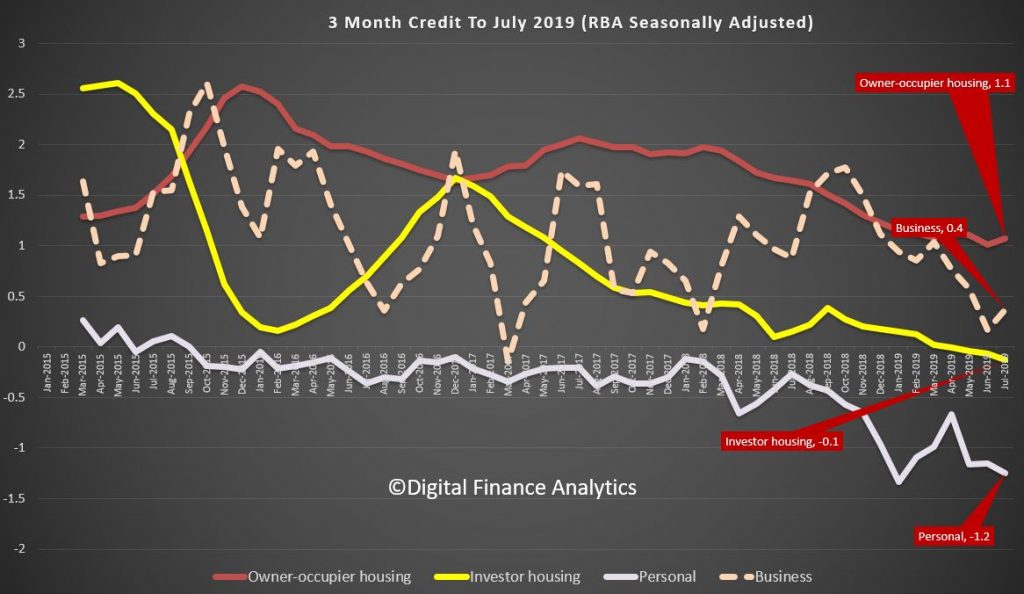
We expect a further rise in the results to be released at the end of September, to end August 2019
In addition, as reported in the AFR, they are being encouraged to lend.
Scott Morrison says Australia’s banks must not shy away from lending after the Hayne commission as he pushes back against what he calls an “instinctiveness” in society towards responsible lending standards that are too onerous.
Speaking to the Australian American Association in New York, the Prime Minister said that while it was important to implement the findings of the royal commission, as well as other reforms such as the Banking Executive Accountability Regime, “we need our banks to keep lending”.
“We can’t be scared of our own shadows in our economy, the animal spirits in our economy and the role of the banking and financial system in extending credit.
And lenders are responding with a tranche of mortgage rate cuts to attract new borrowers or new refinances (rather than passing cheaper funding costs through to existing borrowers).
For example, the Commonwealth Bank of Australia changed its New Wealth Package fixed rates for owner-occupied and investment home loans, for both new and existing customers switching to a fixed rate home/investment home loan as of Tuesday, 24 September.
The largest rate drop is for owner-occupiers with interest-only home loans on a five-year fixed rate, who will see rates drop by 90 basis points to 3.99 per cent, as will investors with an interest-only home loans on a four-year fixed rate.
Owner-occupiers with IO mortgages on one-year and four-year fixed rates will see rates drop by 65 basis points (to 3.89 and 3.99 per cent, respectively), while those with a three-year fixed rate will see their new rate start from 3.79 per cent (10 basis points lower than previous).
Other sizeable rate drops include investors with a four-year fixed rate on P&I repayments, who will see their interest rates fall by 75 basis points to 3.64 per cent.
Investors with P&I repayments on other fixed rate terms will see rates drop from between 5 and 50 basis points.
Owner-occupiers with a P&I home loan that is on a one-year fixed rate term will see a range change of 60 basis points, dropping the new rate to 3.29 per cent. Those with a four-year fixed rate will also see their rates drop by the same amount, bringing the new rate to 3.49 per cent.
And ME Bank announced reductions of up to 49 basis points across its variable home loan products for investors.
The rate reduction announcement comes a week following ME bank’s 2019 financial year results, which saw its home loan portfolio grow by 7.3 per cent, from $24.5 billion to $26.3 billion (or 2.5 times system growth).
The bank has cut rates for investors on both principal and interest (P&I) and interest-only (IO) loans with a loan-to-value ratio of less than, or equal to, 80 per cent.
The changes have been applied to the “flexible home loan member package” for investors, as well as the “basic home loan” investor product, with all changes effective as of Tuesday, 24 September 2019.
The largest rate reduction (49 basis points) was applied to the bank’s basic home loan product, for investors making principal and interest repayments.
For investors on the bank’s basic home loan product, the new rates are as follows:
Investors currently on the flexible home loan package (which requires an annual fee of $395) will see the following changes:
So to Philip Lowe’s recent speech “An Economic Update” where he said that…
…the global economy is that while it is still growing reasonably well, the risks are increasingly tilted to the downside. The main source of these downside risks are geopolitical developments in many parts of the world. These developments are creating considerable uncertainty and this uncertainty is causing businesses to reconsider their spending plans. This is making the international environment more challenging for us.
On the Australian economy, he said after having been through a soft patch, a gentle turning point has been reached. While we are not expecting a return to strong economic growth in the near term, we are expecting growth to pick up. Against this backdrop, the main source of domestic uncertainty continues to be the strength of household spending.
He went on to say over the past year, there has been no growth at all in consumption per person, which is an unusual outcome at a time when employment is growing strongly (Graph 9). An important part of the explanation here is that household disposable income has been increasing only slowly for an extended period, reflecting both subdued wage increases and strong growth in taxes paid.
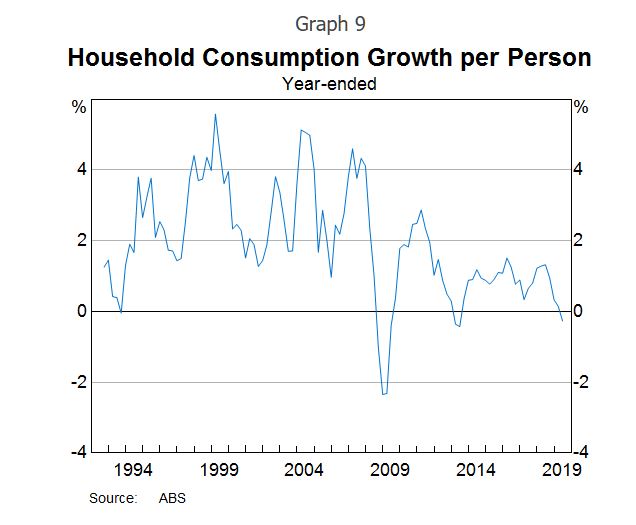
The persistence of slow growth in household income has led many people to reassess how fast their incomes will increase in the future. As they have done this, they have also reassessed their spending, particularly on discretionary items, which has been quite weak over recent times (Graph 10). Not surprisingly, spending on household essentials has been much less affected.
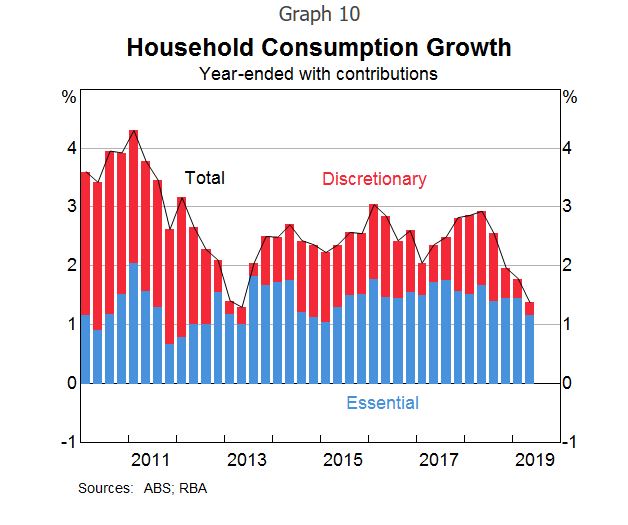
Another part of the explanation for weak growth in household spending is the adjustment in the housing market. As housing prices have fallen, there has been a marked decline in housing turnover, with the turnover rate having declined to the lowest level in more than 20 years (Graph 11). With fewer of us moving homes, spending on new furniture and household appliances has been quite soft. So too has expenditure on moving costs and real estate fees. More broadly, the correction in the housing market has also affected the economy through its impact on residential construction activity.
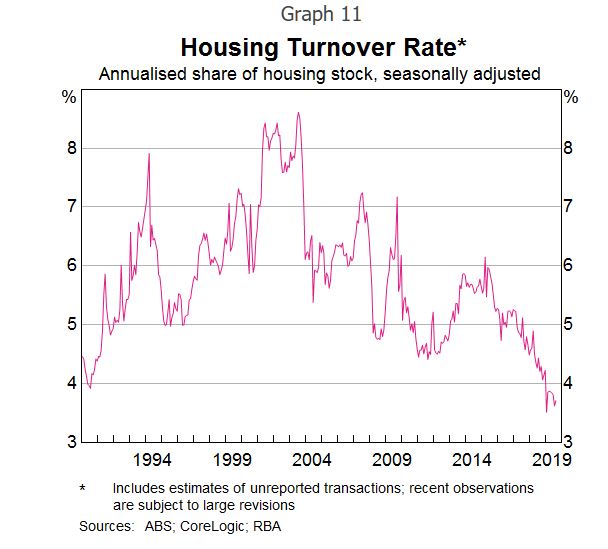
Thus, we can join the dots, if banks lend more and stoke the housing market, this may reverse the weak consumer spending and drive the economy harder. This is of course why the Government and regulators are doing all they can to pull prices higher (though volumes remain very low, and the number of new listings have hardly moved).
And according to the ABC, more building firms are failing.
Statistics, provided by ASIC, show 169 NSW-based construction companies went into administration, receivership or a court-ordered shutdown in the June quarter — the highest number since the September quarter in 2015.
Over the whole 2018-19 financial year, 556 construction companies went under — 101 more than the previous financial year.
Experts say it is a reflection of the state’s slowing apartment and housing market, with about 50,000 less apartments being constructed compared to the same time two years ago, and a marked slowdown in housing construction.
An increasing number of half-finished apartment projects are doting the Sydney landscape, with property development giant Ralan Group — which collapsed in July owing $500 million to creditors — the most high-profile example.
Yet, despite all this in a Q&A the Governor was asked if he was concerned about the recent developments in the housing market. Lowe said the RBA was not worried about the recent lift in dwelling prices and he does not expect credit growth to materially lift due to lower interest rates – meaning that the recent acceleration in the housing market will not be an impediment to a near term rate cut.
In fact the only point of resistance against looser lending and more credit is ASIC’s appeal against the recent ruling relating to HEM (Household Expenditure Measures) that found knowing a customer’s current living expenses was immaterial to deciding whether they could afford repayments on a loan.
In the most famous line of his judgment, Justice Perram found that
“Knowing the amount I actually expend on food tells one nothing about what that conceptual minimum [of how much one can spend without going into “substantial hardship”] is. But it is that conceptual minimum which drives the question of whether I can afford to make the repayments on the loan.”
ASIC commissioner Sean Hughes said the regulator felt compelled to appeal after Justice Perram ruled that a lender “may do what it wants in the assessment process”.
“The Credit Act imposes a number of legal obligations on credit providers, including the need to make reasonable inquiries about a borrower’s financial circumstances, verifying information obtained from borrowers and making an assessment of whether a loan is unsuitable for the borrower,” he said in a statement.
“ASIC considers that the Federal Court’s decision creates uncertainty as to what is required for a lender to comply with its assessment obligation, nor does ASIC regard the decision as consistent with the legislative intention of the responsible lending regime.
“For those reasons, ASIC will appeal to the Full Court of the Federal Court.”
If ASIC loses then the final drag on future credit growth will be blown away.
I have to say, I find this whole narrative very unconvincing. Remember home prices relative to income remain very stretched, the debt burden has never been higher, and yet people are being encouraged to borrow big, and help resurrect the housing market (and the economy), at any cost.

If rates are cut again, the flow of credit will rise (thanks to the APRA changes and heightened competition among lenders). And of course the main driver of this is that banks need lending growth to drive future profitability. But my own modelling suggests that as we approach the zero bounds, profitability will actually be squeezed some more. That said, we can see why it is that Mortgage Growth is The Only Game In Town. From Polys, to Regulators, to Lenders, they all want it. Household though will bear the consequences.
Fitch Ratings says residential mortgage loans in Scandinavia, the Netherlands and Switzerland have seen exceptionally strong performance despite high loan-to-value (LTV) ratios and significant household debt. This reflects generous social security systems and large household wealth, which are a common denominator of these ‘AAA’ rated jurisdictions with strong public finances.

The growth of housing debt in Scandinavia, the Netherlands and Switzerland can be explained by a combination of tax deductibility, low interest rates, and unique features of each respective mortgage market. These include long contractual tenors and interest-only periods. Limited repayment has made borrowers more sensitive to house price decreases. However, macro-prudential requirements in each country are helping to address the risk that high household debt could jeopardise financial stability.
Macro-prudential measures were originally focused on maximum LTV and stressed affordability at origination, but lower mortgage rates continued to stimulate mortgage growth. Banking authorities therefore imposed minimum mortgage loan amortisation as well as maximum loan-to-income (LTI) or debt-to-income ratios. Such restrictions have contributed to the recent adjustment in Norwegian and Swedish house prices and limited lending growth in Denmark. Swiss regulators have tightened capital requirements for banks and promoted self-regulation, which established minimum amortisation for mortgages above 66% LTV. Gradual changes to tax incentives and underwriting standards were introduced by the Dutch authorities, especially since 2013, which have made the mortgage market more resilient.
Australian prime home loan arrears fell in July in all states except NSW and South Australia, but they remain above their five-year average, new data from Standard & Poor’s has shown, via The Adviser.
The Standard & Poor’s Performance Index (SPIN) for Australian prime mortgages dropped to 1.49 per cent in July 2019, down from 1.51 per cent a month earlier, S&P Global Ratings’ recent RMBS Arrears Statistics: Australia report showed.
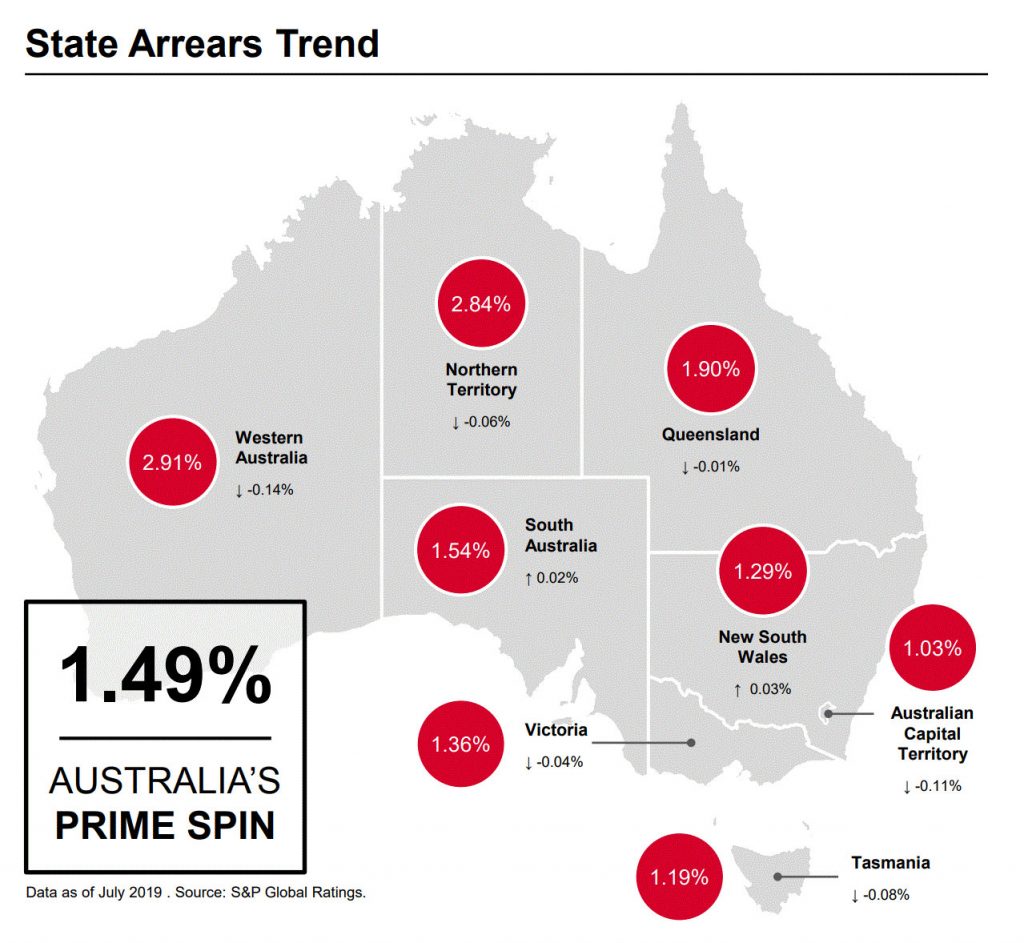
According to the data, which measures the weighted average of residential mortgage loans that are more than 30 days past due in publicly and privately rated Australian RMBS transactions, prime arrears typically drop in spring and are expected to decline during the third quarter of the year.
However, while the arrears index dropped month-on-month, the data showed that arrears were 11 basis points higher than they were in July 2018 and remain above their five-year average of 1.25 per cent.
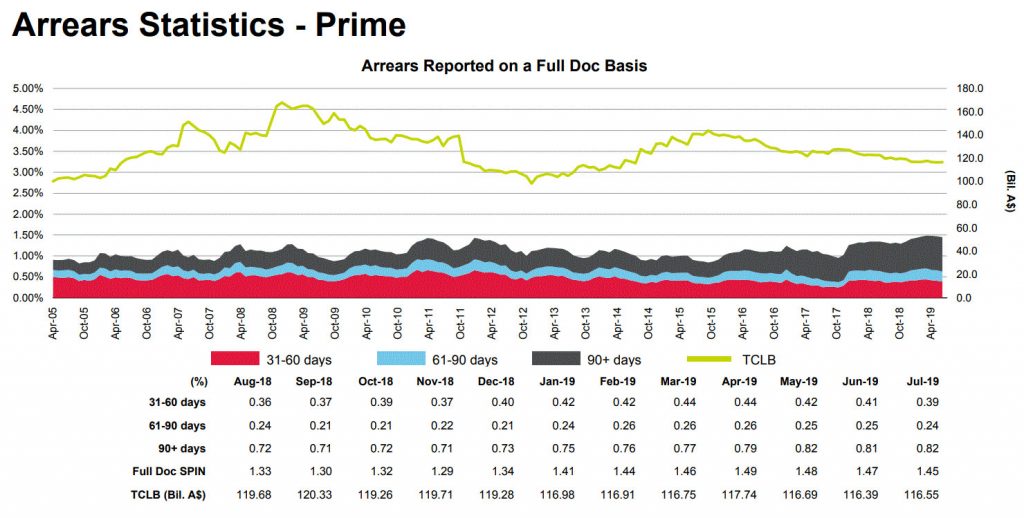
Looking at arrears on a national level, arrears improved in six states and territories, with NSW and South Australia showing an uptick in arrears.
NSW saw an increase to 1.29 per cent, while South Australia saw arrears rise to 1.54 per cent in July 2019.
Western Australia recorded the largest drop in arrears during July, with the rate decreasing 14 basis points to 2.91 per cent.
According to S&P, the majority of this improvement was for loans 30-60 days in arrears. Loans more than 90 days in arrears, however, continued to increase in the western state.
Owner-occupier arrears improved in July, falling by 3 basis points to 1.71 per cent.
However, investor arrears remained mostly unchanged in July, falling by 1 basis point to 1.46 per cent from the previous month.
According to S&P, this partly reflects the “generally tighter lending conditions for investors in the current environment”.
“We expect arrears to continue to decline as the recent rate cuts filter through. These improvements are likely to be seen in the earlier arrears categories, which are more sensitive to interest-rate movements. We expect longer-dated arrears to remain elevated in a softer economic environment,” S&P analysts stated.
“Recent rises in housing finance approvals could bolster refinancing conditions, which started to improve in July, rising 5.4 per cent in seasonally adjusted terms. This will help to stabilize arrears and prepayment rates if the current momentum continues because refinancing is a common way for borrowers to self-manage their way out of arrears.”
RBA on the rising arrears rate
The level of mortgages past due has been noted in recent months, with the Reserve Bank of Australia’s head of financial stability, Jonathan Kearns, noting in June that the number of people in arrears on their home loans had reached the highest level recorded since the global financial crisis.
In an address to the 2019 Property Leaders’ Summit in Australia in June, Mr Kearns discussed the factors contributing to the continual rise in home loan arrears.
Mr Kearns claimed that “cyclical upswings” in arrears were attributable to weak economic conditions, which include falling or stagnant wages and softness in the housing market – which may inhibit some borrowers from selling their property to ease their mortgage burden.
The head of financial stability also acknowledged that tighter lending standards can conversely impact a borrower’s ability to meet their mortgage repayments, pointing to previous restrictions on interest-only lending, which prevented borrowers from rolling over the interest-only period.
Mr Kearns also conceded that tighter serviceability measures may prevent distressed borrowers from refinancing their loan, cited by S&P as one of the factors contributing to the rise in delinquencies.
However, Mr Kearns pointed to internal data collected by the Reserve Bank, which suggested that the application of tighter lending standards has been “effective” in improving credit quality.
Mr Kearns said at the time that he expected the overall arrears rate to continue rising, but he claimed the trend would not pose a significant threat to financial stability.
“To the extent that we can point to drivers of the rise in arrears, while the economic outlook remains reasonable and household income growth is expected to pick up, the influence of at least some other drivers may not reverse course sharply in the near future, and so the arrears rate could continue to edge higher for a bit longer,” he said.
“But with overall strong lending standards, so long as unemployment remains low, arrears rates should not rise to levels that pose a risk to the financial system or cause great harm to the household sector.”
A quick reminder of our live stream event tomorrow, plus we share some new data on Australian sub-prime mortgages and refinancing.

A quick reminder of our live stream event tomorrow, plus we share some new data on Australian sub-prime mortgages and refinancing.
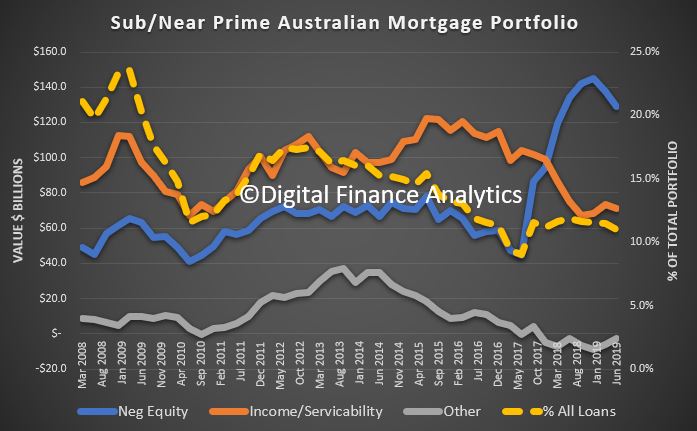
Non-bank lender Pepper Money has launched mortgage lending operations in New Zealand, offering advisers in New Zealand the technology and tools to write its prime, near-prime and specialist loans. Via The Adviser.
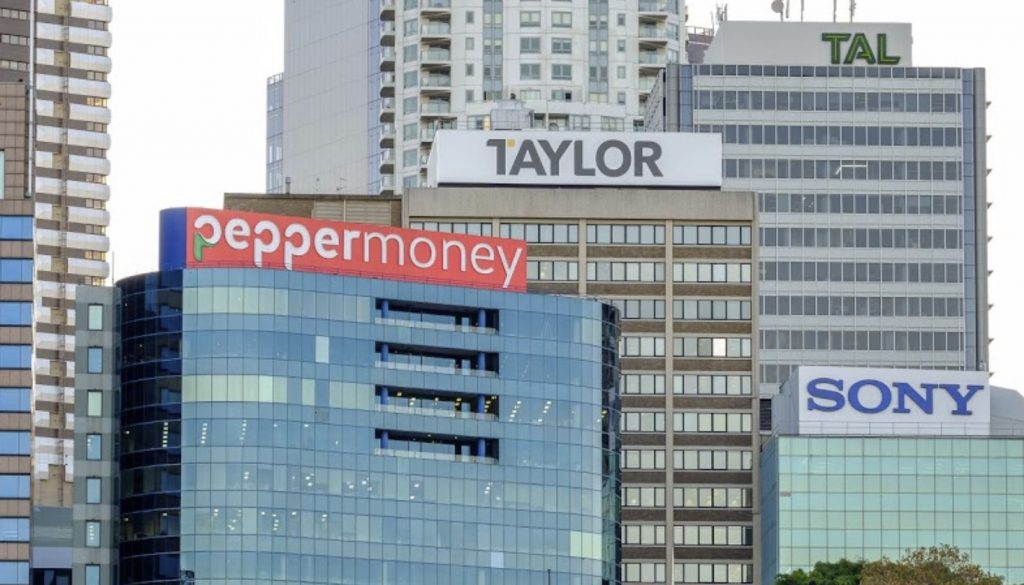
Following more than a year of consultation with advisers and intermediaries, lending partners, regulators and borrowers, Pepper Money has today (16 September) opened its business in New Zealand.
This builds on the international reach of the non-bank lending group, which already operates in Australia, the UK, Spain, Ireland and Asia.
New Zealand-born Aaron Milburn, Pepper Money’s director of sales and distribution in Australia, will head up the New Zealand business from today. His new job title will be director of sales and distribution for Australia and New Zealand.
Speaking to The Adviser about the new business, Mr Milburn said that Pepper Money will primarily distribute through the third-party channel, as it does in Australia.
Mr Milburn added that while while the company may look to launch mortgages directly in future, “the initial plan – and for the foreseeable future – is to utilise the adviser network over there”.
He explained: “We will initially distribute through the adviser network in NZ through all of the major aggregators that operate in New Zealand.
“Pepper’s business is 95 per cent driven through brokers in Australia and in the UK, and we see no need to change that model as we enter NZ.”
He continued: “We think that advisers do a wonderful job in New Zealand, and we would like to continue to support that area of distribution as we enter NZ, as we do in Australia.”
Mr Milburn told The Adviser that his first priority in his expanded role will be to launch the suite of products in New Zealand and “deliver what advisers have been asking for at our various feedback sessions and study tours”.
According to the director of sales and distribution for Australia and New Zealand, this largely focuses around filling a “significant gap in the near-prime space in New Zealand, where families are potentially paying too much or have been in the wrong products due to a lack of choice” and providing advisers with supporting tools to help deliver these products.
He explained: “We had advisers in New Zealand contacting Pepper asking us to go over there and really inject some competition into the market and make it easier for advisers and, ultimately, Kiwi families to realise their goals.”
Pepper Money will therefore also offer advisers the Pepper Product Selector (PPS) tool in New Zealand, which will enable brokers to “get indicative offers for their customers in under two minutes”, as well as a “fully online integrated submission platform for brokers,” the marketing toolkit, the social media toolkit and the Pepper Insights Roadshow.
Pepper Money to pay trail
Notably, while the majority of lenders in New Zealand went through a “no trail” period starting in 2006 (when payments went from 0.65 of a percentage point in upfront commission plus 0.20 of a percentage point in trail commission to an average of 0.85 of a percentage point in upfront only), several lenders have begun returning to trail commission to reduce instances of churn.
According to Mr Milburn, Pepper Money in New Zealand will be offering advisers an upfront and trail commission.
He told The Adviser: “Overwhelmingly, the feedback was that an upfront and trail model was preferred.
“A number of banks have either re-implemented trail in NZ or are looking to in the near future, so we took the opportunity to put trail back into the New Zealand market with our products.”
Mr Milburn concluded that the new operation in New Zealand would build on the practice and service offerings built in Australia.
He said: “We will continue to deliver the level of service and solutions that we do today and continue to really focus on that technology improvement side of things.
“We want to make it easier and faster for brokers to provide solutions for their customers and help build their brand out in the community and the focus will continue in the back end of 2019 to 2020.”
We review the latest APRA data, consumer sentiment, and other burning issues.
https://www.apra.gov.au/publications/quarterly-authorised-deposit-taking-institution-statistics